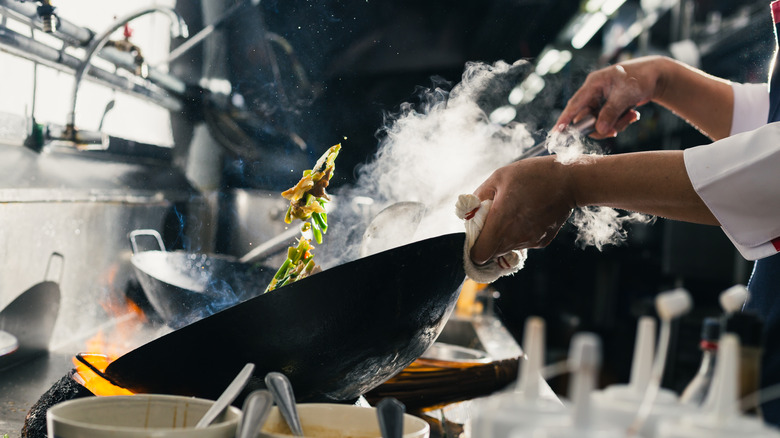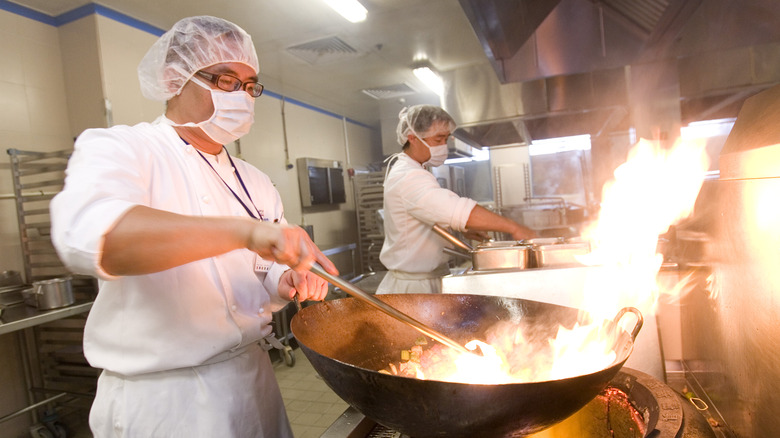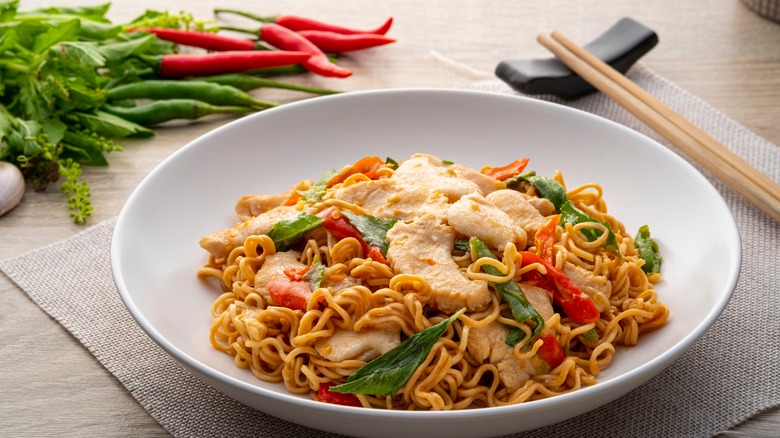Everything You Need To Know About Wok Hei
Ask a Cantonese cook or food fan what "wok hei" is, and the more matter-of-fact, like foodie J. Kenji López-Alt, might refer to it as "that smoky flavor," per The New York Times. A more poetic description of wok hei comes from YouTube cooking star Steph Li, who calls it an "ethereal thing ... that taste of the first bite of a hot restaurant stir-fry. It's got that taste of the restaurant oil, the slightly deeper restaurant browning, the heavier restaurant seasoning."
Wok hei has a literal translation, which Michelin says is "breath of a wok" and refers to the bouquet which arises from a just-cooked stir-fried dish, and which can only happen when food is cooked at very high heat. Unfortunately, the heat that professional chefs generate to achieve wok hei may be challenging to achieve on a home stove top, because these are only capable of providing 12,000 BTU of heat at most, per The Kitchn, while Serious Eats says the most powerful commercial wok burners can go between 65,000 BTU to a head turning 210,000 BTU. As López-Alt points out, "Even the weakest [commercial stove] is six times as powerful as the hottest burner on your stovetop."
Wok hei is the result of shallow stir frying at high heats
On his YouTube channel, cooking expert Tak Cheung explains that the tastes Chinese food fans associate with wok hei are actually the result of shallow stir-frying, which in this instance triggers the Maillard reaction or when temperatures of between 250 F to 300 F causes ingredients to develop new flavor molecules. That wok hei is the result of the Maillard reaction makes it less of a product of culinary alchemy, and something that can be achieved at home.
The secret to achieving wok hei, as J. Kenji López-Alt reveals in The New York Times, doesn't just come from using a super hot stove top. It's also important to use a wok — and he expresses a preference for ones made with carbon steel. A wok's bowl shape allows for heat to be concentrated in one spot: at the bottom. Cooks Illustrated's Lan Lam points out that "the bottom of a wok is the hottest part ... Food that passes through this part of the pan cooks rapidly and acquires flavorful browning." This would also explain why using a skillet makes wok hei difficult to achieve.
Heat is an important part of creating wok hei
Tak Cheung further explains on his YouTube channel that the secret to a good stir fry is the application of constant levels of heat, and which is evenly distributed. This means starting your stir fry with a super hot wok — ensuring that the pan is not overwhelmed by too many ingredients, which will cool the pan down — and turning the heat up or down as needed, to prevent a dish from not cooking thoroughly or burning. This need to keep temperatures constant explains why chefs are seen tossing ingredients rapidly, which keeps heat evenly distributed, and allowing for the Maillard reaction to take place.
J. Kenji López-Alt says there are two extra things a home cook can do to achieve wok hei: One is to add liquid seasoning like soy sauce "around the perimeter of the wok" to give food a "seared soy sauce flavor" (via The New York Times). The second is to take a culinary blow torch in a method he calls "torch hei" — and that involves laying food in a single layer, and on a baking sheet, then "giving it a few leisurely tosses with a torch" to give it a smoky touch. While torch hei might work at home, don't expect to see it practiced at a Chinese restaurant.


